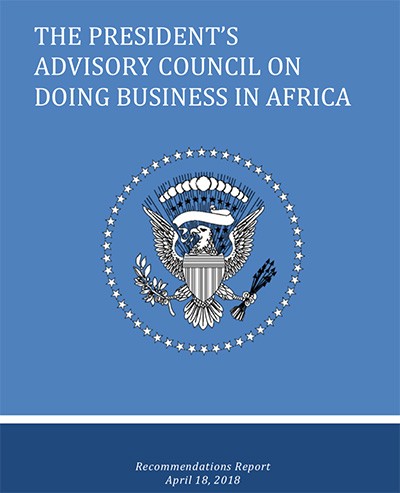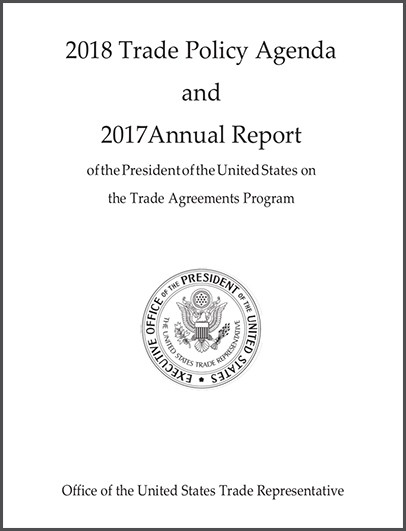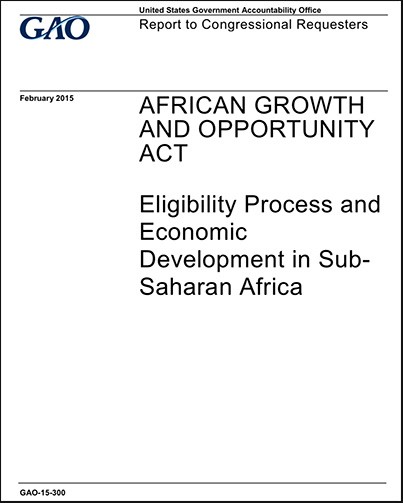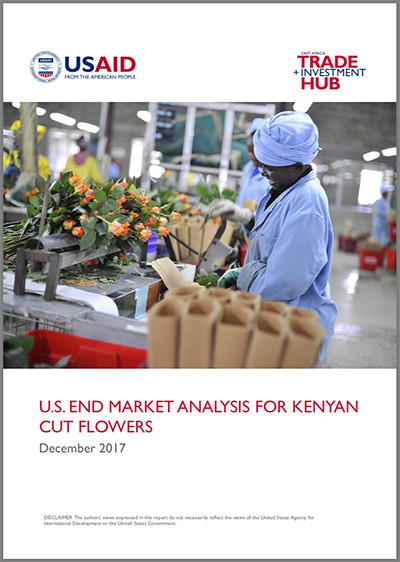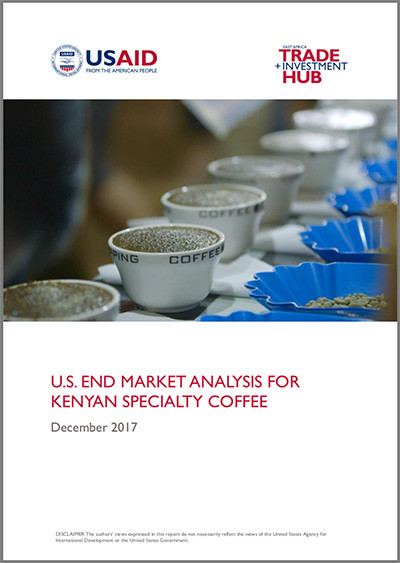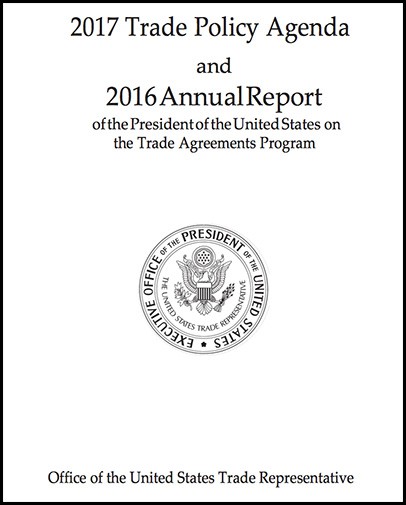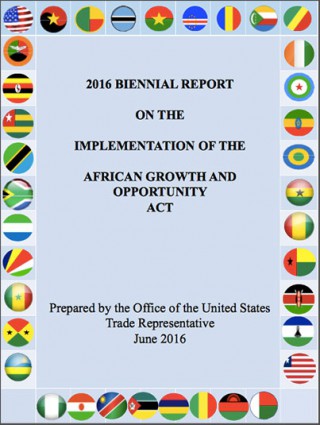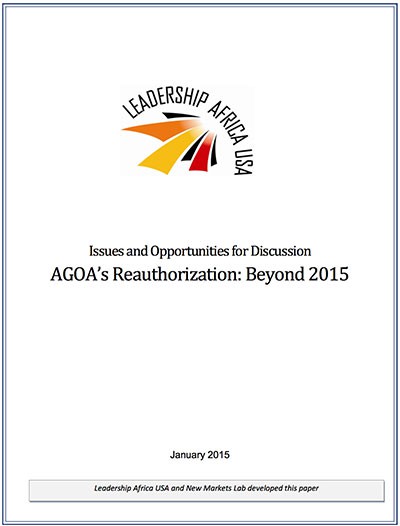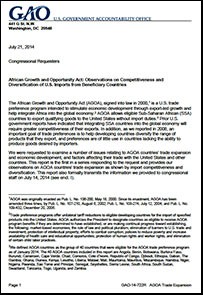Documents & Reports
The President's Advisory Council on doing business in Africa
The President’s Advisory Council on Doing Business in Africa advises the President, through the Secretary of Commerce, on ways to strengthen commercial engagement between the United States and Africa. Members receive no compensation for their efforts on the Council. This report was prepared by the private-sector members of the Council. The views expressed in this report do not necessarily reflect those of the Administration or individual members of the Council.
2018 Trade Policy Agenda and 2017 Annual Report
The 2018 Trade Policy Agenda and 2017 Annual Report of the President of the United States on the Trade Agreements Program are submitted to the Congress pursuant to Section 163 of the Trade Act of 1974, as amended (19 U.S.C. 2213). Chapter V and Annex II of this document meet the requirements of Sections 122 and 124 of the Uruguay Round Agreements Act with respect to the World Trade Organization. In addition, the report also includes an annex listing trade agreements entered into by the United States since 1984. Goods trade data are for full year 2017. Services data by country are only available through 2016.
Eligibility Process and Economic Development in Sub-Saharan Africa
The U.S. government uses the annual eligibility review process required by the African Growth and Opportunity Act (AGOA) to engage with sub-Saharan African countries on their progress toward economic, political, and development reform objectives reflected in AGOA's eligibility criteria. Managed by the Office of the United States Trade Representative, the review process brings together officials from U.S. agencies each year to discuss the progress each country is making with regard to AGOA's eligibility criteria and to reach consensus as to which countries should be deemed eligible to receive AGOA benefits. Over the lifetime of AGOA, 13 countries have lost AGOA eligibility, although 7 eventually had it restored (see figure). To encourage reforms, the U.S. government will engage with countries experiencing difficulty meeting eligibility criteria and may specify measures a country can take. For example, U.S. officials met with Swaziland officials over several years to discuss steps to improve labor rights. However, Swaziland did not make the necessary reforms and lost eligibility effective in January 2015.
US trade and investment with Sub-Saharan Africa: Recent developments
US end-market analysis for Kenyan textiles and apparel
The apparel market in the United States (U.S.) is the largest in the world with a market value of $343 billion. In 2016, the U.S. imported apparel worth $105 billion, up from $88 billion in 2015 and $82 billion in 2014.1 U.S. consumers spent $312 billion on apparel. Ten countries account for almost 80 percent of all U.S. apparel imports with China topping the list with a 30 percent share. While Kenya does not yet stand among these countries, there is an opportunity for Kenya to take advantage of its trade preferences under the African Growth and Opportunity Act (AGOA) to increase its exports to the U.S. market. Since AGOA was signed for an additional ten-year term in 2015, there has been a growing trend toward sourcing and importing apparel to the U.S. If more stakeholders in both countries realize AGOA’s full potential, Kenyan apparel exports can continue to climb. This report focuses on six target product opportunities for Kenyan exporters: Knitted Shirts in Synthetics for all genders and ages T-shirts in Cotton and Synthetic for all genders and ages Sweaters in Synthetic for all genders and ages Woven Pants and Shorts in Cotton and Synthetic for all genders and ages Woven Shirts in Cotton and Synthetic for all genders and ages Dresses for Women and Girls in Cotton and Synthetic as part of SME products These products were determined by volumes and trends and are not unique to Kenyan production. However, these products offer opportunities for large duty...
US end-market analysis for Kenyan cut flowers
Cut flowers are a major export industry in Kenya. Kenya presently ranks first among world exporters of roses to the European Union (EU), with a market share of 38 percent. However, the country has not yet made as deep of inroads into the cut flower market in the United States (U.S.). Kenyan cut flower exports to the U.S. have grown since 2010, but the country’s market share remains small, standing at 1 percent. This report analyzes emerging opportunities to increase Kenyan flower exports to the U.S. while taking advantage of the benefits granted under the African Growth and Opportunity Act (AGOA). In 2016, Kenya ranked as the twelfth greatest supplier of cut flowers to the U.S. Nearly 90 percent of the cut flowers imported by the U.S. come from three countries: Colombia (59 percent), Ecuador (22 percent) and the Netherlands (7 percent). Colombia and Ecuador, who make up more than 80 percent of the imported flowers, present stiff competition. The countries profit from longstanding commercial relationships with the U.S. and geographic proximity, which reduces freight and transport costs. Both countries enjoy duty-free access to the U.S. market, as does Kenya. Nonetheless, Kenya has a strong, competitive cut flower industry that is ready to explore new markets. The industry is profitable and technically competent, it has developed efficient logistics to the European markets and it offers high-quality flowers at competitive prices. If the industry can use these strengths...
US end-market analysis for Kenyan home decor and fashion accessories
This report provides market data at a product level for use by Kenyan exporters interested in the United States (U.S.) market and to support the National African Growth and Opportunity Act (AGOA) Strategy and Action Plan for Kenya. The home décor and fashion accessories sector has the capacity to further the goals of increasing women and youth participation in manufacturing by providing greater access to economic opportunities. In 2016, the top preforming Kenyan product categories in this sector represented $5.2 million in exports to the U.S. The U.S. is the largest importer in the world in all categories, and the fourth largest in jewelry. This report analyzes the top supply growth opportunities for Kenya based on the U.S. import demand. It also presents the current market trends in the U.S. for Kenya to better compete internationally. In addition, the Kenya Vision 2030 makes the recommendation for "a better and more inclusive wholesale and retail trade sector." Accomplishing the goal of increasing efficiency, lowering transaction costs and strengthening trade as well as linking trade to wider local and global markets requires: Understanding the demands of the international market and the trends that influence the global exports to the U.S. market; Understanding the advantages of the Kenyan market in key product categories, competitiveness in raw material sourcing, and the international competitors participating on the global stage; Sharing a detailed explanation...
US end-market analysis for Kenyan tea
The tea market in the United States (U.S.) is growing, with Americans consuming larger quantities of tea each year. In 2016, the U.S. imported nearly $760 million in tea (excluding herbal tea), making it the world’s third largest tea importer.1 According to the Tea Association of the USA, the sector projects compound annual growth rates of 3 to 5 percent over the coming years. This has been driven by an increase in volume, but especially value, of tea imports. Approximately four out of five Americans drink tea. For Millennials, tea consumption reaches an estimated 87 percent. This population, in particular, is driving the upward trend in tea consumption and price. Consumers are becoming more health-conscious and are therefore willing to pay for better quality tea and innovations in flavors, packaging, and convenience. Black tea, specialty teas, and Ready-to-Drink (RTD) tea are experiencing the highest rates of growth. Black tea, which accounts for 85 percent of U.S. tea consumption, achieved 2.3 percent growth in imports between 2015 and 2016. Sales of specialty teas, comprised of loose-leaf teas, single-estate teas, Fairtrade, organic, or rare teas, are increasing about 10 percent per year. Further, RTD tea is expected to grow 4 to 6 percent over the next five years. The U.S. market is highly competitive. It is comprised of a handful of U.S. growers and numerous importers that are supplied by exporters from almost every tea producing country. In 2016, the U.S....
US end-market analysis for Kenyan speciality coffee
The United States of America (U.S.) is the largest market for coffee in the world. Within the U.S. coffee sector, the specialty coffee industry imports almost 750 million kilograms (kg) of green, specialty-grade coffee from around the world each year, often paying double the commodity price. Specialty-grade coffees are identified by their high-quality, unique taste characteristics and countries of origin. They are roasted by one of 1,400 U.S. roasters and distributed to hundreds of thousands of coffeehouses, supermarkets, restaurants, and specialty stores. Whether prepared by retailers or sold in bulk packages for self-preparation at home or in the workplace, 35 million Americans drink specialty-grade traditional coffee on a daily basis. As geographic origin plays a major role in the taste and body characteristics of specialty coffee, it can be broadly distinguished by growing region – Latin America, Asia/Pacific or Africa. East Africa currently contributes about 4 percent to the volume of annual U.S. green Arabica imports, the predominant species of specialty-grade coffee. Imports from Kenya alone account for about 6 percent. While Kenya could improve issues related to the price and volume of quality production, the country has historically had a reputation for quality and continues to compare favorably with other countries. In fact, Kenyan AA1 was the first single-origin coffee widely identified by its origin name in the early days of the U.S. specialty coffee...
Overview of the Used Clothing Market in East Africa: Analysis of Determinants and Implications
Overview of the Used Clothing Market in East Africa: Analysis of Determinants and Implications. In March 2016, the East African Community (EAC) Heads of State issued a Joint Communiqué from the 17th Ordinary Summit, expressing their intent to progressively phase out importation of used clothing as a means to support the region’s textile and apparel industry.* A U.S. trade association reacted to these measures by requesting an out-of-cycle review (OCR) of the eligibility of the EAC Partner States for the African Growth and Opportunity Act (AGOA) privileges, citing both loss of American jobs as well as introduction of new trade barriers in contravention of AGOA provisions. The following is a top level examination of some of the determinants and implications of the used clothing market in East Africa, including an analysis of used clothing import trends in the EAC; an assessment of the economic significance of used clothing to both the U.S. and EAC; a review of EAC import substitution assumptions; and some modeling of long-term outcomes if EAC Partner States maintain their current used clothing import policies. The results provided are intended to aid data-driven policy decisions and negotiations going forward.
2017 trade policy agenda and 2016 annual report of the president of the United States on the trade agreements program
On March 1, 2017, the Office of the U.S. Trade Representative (USTR) posted the 336 page 2017 Trade Policy Agenda and 2016 Annual Report of the President of the United States on the Trade Agreements Program. The reports are required to be submitted to the U.S. Congress by March 1, pursuant to Section 163 of the Trade Act of 1974, as amended (19 U.S.C. 2213). Chapter II and Annex II of the document are intended to meet the requirements of Sections 122 and 124 of the Uruguay Round Agreements Act with respect to the World Trade Organization. In addition, the report also includes an annex listing trade agreements entered into by the United States since 1984. Goods trade data are for full year 2016. Services data by country are only available through 2015. The Office of USTR states that it intends to submit a more detailed report on the President’s Trade Policy Agenda after the Senate has confirmed a USTR, and that USTR has had a full opportunity to participate in developing such a report. The Trade Policy Agenda portion outlines the trade policy objectives and priorities of the United States for 2017, and reasons therefor. The Agenda states that, “The overarching purpose of our trade policy – the guiding principle behind all of our actions in this key area – will be to expand trade in a way that is freer and fairer for all Americans.” It lists the following key objectives: Ensuring that U.S. workers and businesses have a fair opportunity to...
2016 Biennial Report on the implementation of the African Growth and Opportunity Act
The U.S. Trade Representative presented to Congress today a comprehensive report on implementation of the African Growth and Opportunity Act (AGOA) – the cornerstone of the U.S. trade and investment relationship with sub-Saharan Africa. The report is statutorily mandated by Congress under the Trade Preferences Extension Act of 2015 to be submitted one year following the enactment of the Act, and biennially thereafter. The 2016 Biennial Report on the Implementation of the African Growth and Opportunity Act details the U.S.-sub-Saharan African trade relationship, analyzes country compliance with eligibility criteria, highlights regional integration efforts, and summarises the trade capacity building assistance that various U.S. government agencies provide to Africa. The report also provides information, requested by Congress, regarding out-of-cycle AGOA eligibility reviews and potential trade agreements with sub-Saharan Africa.
AGOA’s Reauthorization: Beyond 2015
access to the U.S. market in a wide range of products. It has become a flagstone of the U.S.-African relationship and has successfully shifted focus to trade and economic issues. AGOA was designed to spur economic development by using trade incentives to promote a level of economic progress and governance necessary to foster robust and fair economic systems in sub-Saharan Africa. The policy priorities of AGOA still ring true and include increasing trade and investment; strengthening the private sector; reducing trade barriers; supporting rule of law, poverty reduction, and economic reform; and encouraging regional integration in Africa, which will also connect the subcontinent more closely to international markets...
AGOA: Observations on competitiveness and diversification of US imports from beneficiary countries
GAO (US Government Accountability Office) was asked to examine a number of issues relating to AGOA countries’ trade expansion and economic development, and factors affecting their trade with the United States and other countries. This report is the first in a series responding to the request and provides GAO’s observations on AGOA countries’ trade expansion as shown by import competitiveness and diversification.


